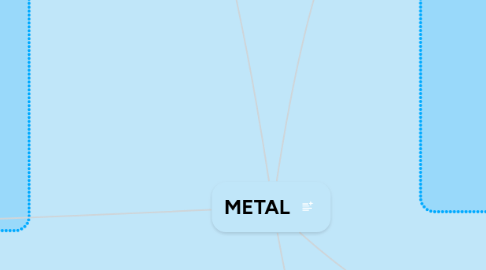
1. - as strong as steel but only half as heavy.
2. Non-ferrous
2.1. Metal elements and alloys that are not an iron based.
2.2. Non-ferrous group metals are
2.2.1. Aluminum
2.2.1.1. - represents a large family of aluminium alloys
2.2.1.2. - high electrical and thermal conductivity
2.2.1.3. - a very ductile material and high formability
2.2.1.4. - soft & not very strong.
2.2.1.5. - adding small amounts of alloying elements, by heat-treating, can increase strength.
2.2.1.6. - alloying can improve corrosion resistance, welding characteristics, & machinability
2.2.2. Copper
2.2.2.1. - corrosion resistant
2.2.2.2. - excellent conductor of electricity and thermal.
2.2.2.3. - can be easily shaped.
2.2.2.4. - low in strength & hardness.
2.2.3. Magnesium
2.2.3.1. - lightest of the structural metals.
2.2.3.2. - soft and low strength for engineering application
2.2.3.3. Desirable characteristics
2.2.3.3.1. high strength-to-weight ratio
2.2.3.3.2. excellent machinability
2.2.3.3.3. ability to be worked by all common metalworking techniques.
2.2.3.4. - alloyed with aluminium, zinc, manganese, zirconium, or thorium for higher strength.
2.2.4. Titanium
2.2.4.1. - bridges gap between Steel & Aluminium.
2.2.4.2. - low coefficient of thermal expansion
2.2.4.3. - extremely resistant to corrosion.
2.2.4.4. - used for high-speed aircraft components.
2.2.4.5. - most can be operated in temps of 800°F
2.2.5. Zinc
2.2.5.1. - low melting point makes it ideal for die-castings.
2.2.5.2. - base metal used in alloys to resist forms of corrosion.
2.2.5.3. - commonly used as a protective coating (galvanising).
2.2.5.4. - moderate strength & toughness.
2.2.5.5. - automotive components, home appliances use large quantities of zinc alloys.
2.3. - one of the strongest metals in use today.
3. High stiffness/hardness
4. Ferrous
4.1. Iron is a base metal or pure metallic element.
4.2. Use iron as their basic ingredient.
4.3. Iron seldom used in its pure state.
4.4. Most are alloys or mixtures of two or more metals.
4.5. Type of ferrous
4.5.1. - contains 3.0% to 4.0% carbon.
4.5.2. Cast iron
4.5.2.1. - hard & brittle with excellent wear resistance.
4.5.2.2. - has a low coefficient of expansion
4.5.3. Steel
4.5.3.1. - content of carbon is between 0.2 – 2.1% by weight.
4.5.3.2. - hard, strong metal used to produce many different materials.
4.5.3.3. - steel with increased carbon content
4.5.3.3.1. can be made harder and stronger than iron, but is also less ductile.
